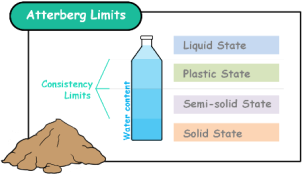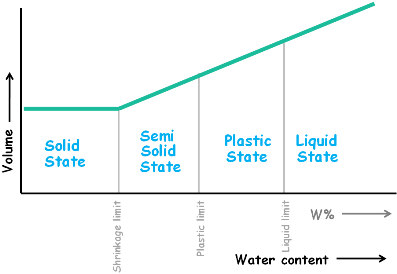 Consistency is a term which is used to describe the degree of firmness of soil. Consistency of a soil is indicated by terms such as soft medium and hard.
Consistency is a term which is used to describe the degree of firmness of soil. Consistency of a soil is indicated by terms such as soft medium and hard.
This property of consistency is defined only for fine grained soils, specially for clays and it is measured for wet, moist and dry soil samples.

Soil consistency is the resistance of soils to deformation and rupture.
The physical properties of soil are considerably influenced by the amount of water present in them. Consistency of a soil also changes with the amount of water.
 A swedish agriculture engineer Albert Atterberg mentioned that depending upon the water content the consistency of fine grained soils can be described in four states. Or in other words we may say depending upon the water content soil may appear in one of these four states
A swedish agriculture engineer Albert Atterberg mentioned that depending upon the water content the consistency of fine grained soils can be described in four states. Or in other words we may say depending upon the water content soil may appear in one of these four states
Liquid State
Plastic State
Semi-solid State
Solid State
In each state, the consistency and behavior of a soil is different and consequently so are its engineering properties. Thus the boundary between each state can be defined based on a change in the soil’s behavior.
 The water content at which the soil changes from one state to other is known as the Consistency limit.
The water content at which the soil changes from one state to other is known as the Consistency limit.
Atterberg demonstrated the significance of these limits in understanding the behaviour of clays. So these limits are also called Atterberg limits.
When we mix fine grained soil in large quantities of water the resulting suspension of soil is called as liquid state of soil. In this state soil has virtually no shear strength which means soil has zero shear strength. Also it offers practically no resistance to flow and it flows like a liquid.
If the water content of the suspension is reduced, the soil becomes stiffer and starts developing resistance to shear.
 This is the stage when the sample changes from possessing no shear strength to possessing an infinitesimal shear strength and changes from the liquid to plastic state.
This is the stage when the sample changes from possessing no shear strength to possessing an infinitesimal shear strength and changes from the liquid to plastic state.
The water content at which soil changes from the liquid to plastic state is known as liquid limit.
In other words the water content at which soil stops being liquid is its liquid limit. It does not flow like a liquid anymore.
 In plastic state soil can be moulded into different shapes without rupturing it due to its plasticity.
In plastic state soil can be moulded into different shapes without rupturing it due to its plasticity.
Now if we further reduce the water content of the soil, its plasticity decreases and finally soil changes its state from plastic to semi-solid.
 In this state if we try to mould the soil, it cracks. Soil loses its plasticity and becomes brittle.
In this state if we try to mould the soil, it cracks. Soil loses its plasticity and becomes brittle.
The water content at which the soil stops being plastic and changes to semi-solid state is called plastic limit of the soil.
Upto this semi-solid state soil remains fully saturated and in with reduction of water content volume of soil mass reduces almost in equal amount.
But there comes a stage when further reduction in water content, volume of soil remains the same. At that point soil mass changes from semi solid state to solid state.

Soil converts into a soil mass which has pores partially filled with water. Now we can understand that if we reduce the water content, soil’s volume remains the same but it’s pore water gets reduced. Hence no volume change with water content reduction. That is soil does not shrink any more. And the water content at which soil stops shrinking, is called its shrinkage limit.
Shrinkage limit can also be defined as the lowest water content at which soil is fully saturated.
If we further reduce the water content below this limit sample begins to dry up at the surface and soil is no longer fully saturated. The colour of the sample also begins to change.

Lets represent it all in a graphical form.
Here we can see with decrease in moisture content of the soil, its volume also decreases. But below the shrinkage limit volume of soil mass remains constant. All these limits are in percentage of water content and are basic measure of the critical water contents of a fine grained soil.






